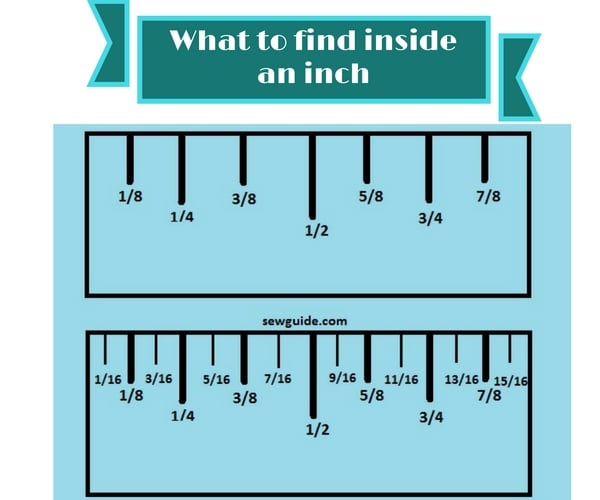
In my teens, I dreaded the tape measure – It represented all the guilt at eating those extra chocolates after the second helping, or was it the third? When I gained weight in my 20s, I threw away the tape measure. Then I discovered sewing.
Tape measure has been a constant companion since then. Actually, tape measures in the plural; because I have at least 4 of them in different rooms. One of them is tucked away in a deep drawer, ready for the contingency situation when all the other three are missing.
When I started to sew and for a long time afterward, I just knew the main marks in the tape measure. A sewing friend then taught me the rest. Something as basic as this should be taught in school rather than some other nonsense that I learned in school, which I never found a use for afterward. In this age of laser measuring tapes, electronic tape measures and measuring tape apps, and easy paper patterns, one (the husband) may wonder at the use of ordinary tape measures. But for me, it is one of the most useful and necessary sewing tools.
As I understand it, there are two types of tape measurements – metric and imperial.
Metric measurement markings represent measurements in centimeters and millimeters and meters.
Imperial measurement markings represent measurements in inches and feet and fractions of inches.
The numbers given represent the whole centimeters and the small lines in between the centimeters lines are the millimeters. Ten millimeters make up one centimeter, and 100 centimeters equals one meter.
Scientists use the metric system, but when measuring the body, most people use the imperial system, i.e., of inches. 36-24-26 is not in centimeters, as you know; they are in inches and the anathema of millions of differently endowed girls. You can learn more about the different systems of measurement and how to convert metric measurement units to imperial units metric in this post on Dimensions of a yard of fabric
Different types of measuring tapes used in sewing
1. The regular measuring tape
Typically a measuring tape for measuring the body is 60 inches long which is about 1.5 meters (152 cms). You get 120 inch long measuring tapes in shops as well, which is useful for measuring those curtains and quilts and other home decor stuff.
My measuring tape comes with a right and wrong end ( with one end stiff with a metal plate), but there are simple ones available with both ends ready to measure.
My measuring tape has metric and imperial measures placed on top and bottom. Only the imperial system is given on the other side of the tape.
The measurements are given as 1/8th of an inch, i.e., one inch is divided into eight parts. Sometimes measurement markings representing 1/16th of an inch are also given. Tape measures and rulers used in construction and design work usually have markings with 1/32 of an inch.
The main middle marking inside the inch represent 1/2 inch ( Half inch)
The next small markings represent 1/4 of an inch ( Quarter inch) & 3/4 of an inch ( three-fourth inch)
The next small markings represent 1/8, 3/8, 5/8 and 7/8 of an inch ( eighth’s of an inch)
.

Inch to millimeter conversion Reference List.
12 inches make a foot. One inch is equal to 2.5 cms or 25 mms.

You use simple maths which you studied (did you ? or slept like me) in school to add the fraction when you have to; to put it simply, 1/4 + 1/4 is 1/2 (ha). To add unequal fractions, you have to make the denominator equal and then add. Let me run before I start teaching gibberish.
When you are using the tape with the metric system or the imperial system, just ensure you measure from the zero line.
Have you realized that the tape measure you have been using for years may need to be revised – it may have stretched out of correct measures? You can replace it with a new one now and then or choose a fiberglass one that is guaranteed to be non-stretchy.
Measuring is very important when making a dress. There is a very often said adage about measuring – measure twice and cut once – very forgettable I would think remembering all the occasions when I had forgotten this one saying – when that expensive fabric was cut a little too short because I didn’t measure twice.
2. Cutter practical guide tape
This is a kind of measuring tape with elastic tape and other tapes attached to a piece of plastic.
3. Trouser Tape
This is a tape measure with a curved thing on top, which helps measure inseam length when measuring for making pants. This ruler measures 45 inches in length (114 cm).
4. Drawing rulers
The big meter scale available in wood, plastic, or metal can be very useful in drawing the long seam line, etc. A smaller Foot rule (scale) measures 12 inches in length and is usually made of plastic, wood, or steel. This is useful when you have to measure seams, small tucks, pleats, etc.
L square is a scale that is made like the capital letter L. This is great for measuring corners as it gives an accurate 90-degree marking. One side ( the long side) will be 24 inches long and the other side 12 inches.
Checkout the post on correctly measuring the body for dress making
